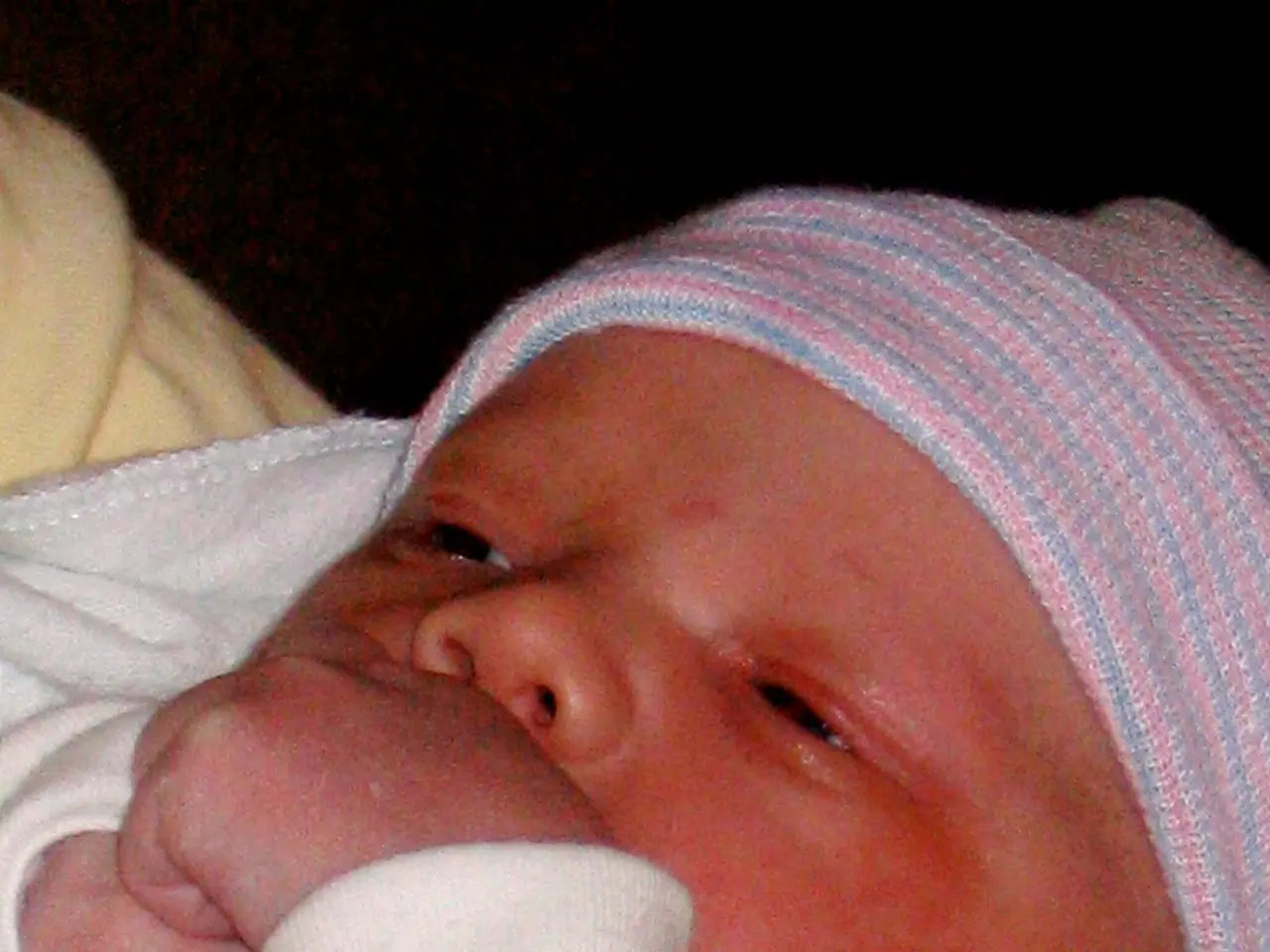Baby Tongue Turning White: Causes, Treatments, and Preventive Measures (Thrush Included)
Distinguishing Milk Residue from Oral Thrush in Newborns
Oral thrush and milk residue are two common conditions that can affect a newborn's oral health. While they may share some similarities, there are key differences between the two.
Milk Residue
Milk residue, also known as milk coating or curdled milk, is a harmless condition that occurs when leftover milk remains in a newborn's mouth after feeding. It appears as a thin, white layer or spots on the tongue and inside the mouth. This film is easily wiped or rubbed away gently with a cloth or gauze after feeding. Newborns who have milk residue usually appear comfortable and do not show any symptoms.
Oral Thrush
Oral thrush, on the other hand, is an infection caused by an overgrowth of the Candida fungus. It shows as thick, white patches or plaques on the tongue, inner cheeks, gums, roof of the mouth, or throat. These patches look like cottage cheese and are firmly attached and difficult to wipe off. Oral thrush can cause pain or discomfort, potentially making the baby fussy, feeding poorly, or crying during nursing or bottle use. Sometimes it may coincide with a yeast diaper rash.
Distinguishing Milk Residue from Oral Thrush
After feeding, gently wiping the baby's tongue and inner mouth with a clean, damp gauze or cloth can help parents differentiate between milk residue and oral thrush. If the white coating wipes away easily, it is likely milk residue. However, if white patches remain after wiping and appear thick or raised, suspect oral thrush. Observe if the baby shows feeding difficulties, fussiness, or pain. Additionally, look for white or yellow patches not just on the tongue, but also on other mouth areas (cheeks, gums, throat), which is more typical of thrush.
Prevention and Treatment
To prevent oral thrush from returning, parents and caregivers can take several steps. Sterilizing feeding equipment, refrigerating pumped milk, treating the nipples for thrush if breastfeeding, wiping the breast dry after every feed, and changing nursing pads frequently can help reduce the risk of reinfection. If oral thrush is suspected, parents should contact a pediatrician for diagnosis and treatment, which usually involves topical antifungal medication.
Summary
In summary, gentle wiping after feeding is a practical way for parents to differentiate milk residue from thrush in newborns. If uncertain, consulting a healthcare provider is recommended. Newborns can transfer the infection when breastfeeding, so a person should also apply the gel to their nipples after every feed to prevent reinfection. At its most severe, a Candida infection may affect the blood, the membrane that lines the heart muscle, and the brain's membranes.
| Feature | Milk Residue | Oral Thrush | |-----------------------------|-----------------------------------|----------------------------------| | Cause | Leftover milk in mouth | Candida fungus overgrowth | | Appearance | Thin, white film or spots | Thick, white plaques/patches | | Removability | Easily wiped away | Difficult to wipe off | | Symptoms | None; baby appears comfortable | Possible pain, fussiness, feeding issues | | Location | Tongue surface | Tongue, cheeks, gums, throat | | Need for treatment | None | Yes, antifungal medication |
- Anew understanding of oral health issues in newborns is essential, particularly the distinction between milk residue and oral thrush.
- Milk residue, causing a harmless thin, white layer on the tongue and inside the mouth, is relatively common but usually has no symptoms and doesn't require treatment.
- Oral thrush, on the other hand, is an infection caused by the Candida fungus that leads to thick, white patches on the tongue and other mouth areas, potentially causing pain, feeding difficulties, and fussiness.
- Prevention measures against oral thrush include sterilizing feeding equipment, refrigerating pumped milk, treating nipples for thrush, and frequent nipple gel application after every feed.
- Treatment for oral thrush usually involves topical antifungal medication, which healthcare providers can prescribe during consultations for a precise diagnosis.
- Science and medicine are instrumental in addressing various health issues, including oral conditions that affect newborns.
- Understanding the symptoms and differences between milk residue and oral thrush is vital for proper parenting and promoting newborns' health and wellness.
- The workplace can prioritize wellness initiatives, addressing not only physical conditions like respiratory or digestive health but also mental health, sexual health, and autoimmune disorders.
- Healthy aging encompasses various aspects, such as skin care, nutrition, cardiovascular health, and others, requiring a balanced approach to medical conditions and therapies and treatments.
- Mental health should not be overlooked and can be managed through seekingsupervision from healthcare professionals and maintaining proper nutrition, weight management, and fitness and exercise.
- Mental health is crucial in maintaining mens' health, women's health, and overall well-being, paving the way for effective self-care and parenting.
- Skin conditions, neurological disorders, eye-health, hearing, and aging can all be addressed through targeted treatments and therapies, ensuring holistic care.
- The use of CBD oil for health and wellness purposes has gained popularity, ranging from addressing anxiety and pain management to promoting sleep and improving fitness and exercise performance.
- Cancers, whether related to respiratory, digestive, or other health conditions, are complex medical issues requiring professional intervention and specific treatment plans.
- Proper nutrition, coupled with healthy exercise, fitness, and aging practices, plays a crucial role in helping manage various medical conditions, from autoimmune disorders to cardiovascular health, enabling individuals to embrace a balanced lifestyle and enjoy life's many aspects.




